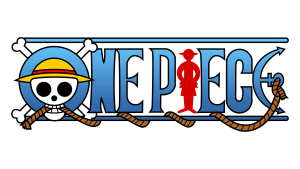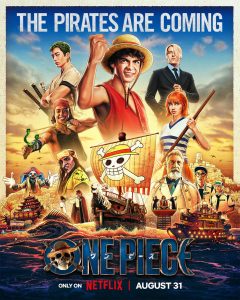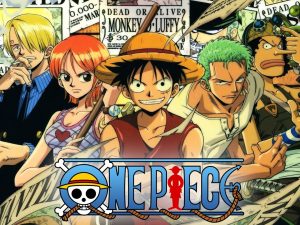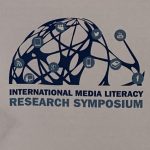Adaptations, or How I Joined the One Piece Fandom
Adaptations, or How I Joined the One Piece Fandom
By Diana Maliszewski with Peter Maliszewski for AML
An adaptation is, according to Merriam-Webster, a composition rewritten into a new form; Cambridge says it’s “something produced to adjust to different conditions or uses, or to meet different situations”. Examining adaptations is a classic media studies approach that even novice educators can comfortably use. Let’s read the book, watch the movie, and then compare the two. Cynically, it often justifies devoting a period or an afternoon to a viewing party.
Adaptations are challenging projects to undertake. Understanding the key concepts of media literacy can help consumers notice the nuances. This article will focus on a particular recent example, the Netflix adaptation of the long-running manga and anime One Piece, but the ideas can be adapted (ha ha) to any other media properties. Use the boxed questions for class discussions.
One Piece: A Brief History
One Piece was created by Eiichiro Oda in 1997 and is considered one of the longest-running, and highest-grossing shonen (series meant for young boys) manga (Japanese comics) of all time. The anime (televised cartoon) is an adaptation of the manga, by Toei Animation Studios and it started in 1999. The anime stays true to the manga’s plot, characters, and art style. Toei creates one episode to coincide with a single chapter of the manga. As of October 2023, there are nearly 1100 chapters and about 1000 episodes of One Piece. The story revolves around a young teen called Monkey D Luffy and his dream to become king of the pirates. Luffy meets several friends and enemies along his journey and gets through many problems by using his powers that he obtained by eating the Gum Gum Fruit. This fruit bestowed on him the ability to stretch.
| Who is the original creator of this text? How does the identity of the creator influence the text?When and where was the original version of this text made?
What was the original reaction to the first version of the text? How does the time difference between an original and an adaptation impact both texts? |
Did Netflix Learn Its Lesson? Cowboy Bebop vs One Piece
When Netflix announced that it was going to produce a live action version of another popular anime, Cowboy Bebop, initial reaction was poor. The creator of Cowboy Bebop, Shinichirō Watanabe, declared publicly that he had no involvement in the making of the live action series. Few people were excited about the prospect of adapting this beloved franchise for many reasons. The visual presentation did not match the aesthetic of the original, the costuming and sets looked cheap, and there were questions about the suitable casting. It was also made clear that the producers were making significant deviations from the source material. In interviews, when asked about these changes, the actors and producers were dismissive of the concerns of old fans and even outright antagonistic at times. Consequently, when the show premiered, it had very poor viewership and was canceled less than three weeks after its release.
One Piece, on the other hand, took a much different approach. Oda was very involved in the making of the live action show and the producers trumpeted this fact frequently. They also declared that the series would not air until Oda himself had approved. In fact, the series was delayed several times for Oda to tweak different aspects of the series that were not true to his vision. The actors of One Piece really respected the source material, which added to their enthusiasm and performance. For instance, the actress who plays Nami, Emily Rudd, is a self-declared fan of the One Piece manga. The One Piece production crew had a much larger budget so the sets and costuming were more faithful to the source material. There were a few changes, where they compressed a larger amount of source material into a shorter amount of time but despite this, the team made every effort to stay true to the spirit of the original. For example, the character of Koby and his interactions with Helmeppo occur much later in the manga but appear in the first season of One Piece as a meaningful parallel to Luffy’s own initial journey. Because there was so much material to work with, the live action adapters foreshadowed elements that will be present in later episodes. When One Piece was released on Netflix on August 31, it became the second most watched Netflix series ever within its first 28 days.
| How does an adaptation help an original media text? How does an adaptation hinder or tarnish an original media text?How do reviews influence the reaction of the public to a new release?
Who profits from the consumption or enjoyment of this text? Why do companies choose to make adaptations instead of produce new content (i.e. the Disney live-action remakes of their animated films)? How much influence does the initial creator have on the interpretation and adaptation of his/her/their texts? |
How Will That Translate? Unique Aesthetic Forms
Adapting manga to anime is a frequent undertaking. Usually the anime gets more people to become interested in the manga. Sometimes the popularity of the anime surpasses the manga, to the point where it creates a divide in the fandom, i.e. the “anime-only” vs the “manga-readers”. This can further split into fans of “dubs” vs “subs” (Japanese anime that is revoiced by English actors as opposed to the use of subtitles). Each of these presentations have their own unique aesthetic forms that impact the enjoyment. The suspense of turning a page does not always translate in quite the same way when animated.
Creating a live-action version of a manga or anime that contains cartoonish superhuman abilities presents a unique challenge. In One Piece, Oda stated that he uses Luffy’s stretching ability to soften the tension that some of the battles would otherwise contain. He claims that One Piece is meant to be fun even when their characters are in peril. Overuse of extensive special effects in the live action would increase production costs and run the risk of appearing ridiculous. Where this adaptation succeeds is that, while it is still more grounded in reality than the manga or anime, its selective and creative way of showing Luffy’s stretching powers (e.g. via camera angles and specific moments) doesn’t stray from Oda’s vision.
| How are the codes and conventions of the original text modified in the adaptation?How do the form and genre shape the content of the text?
What aspects of a certain form are “untranslatable” to another format? |
Court or Alienate the Fans? Make New Friends but Keep the Old? Audience Response
One measure of success in a creative endeavor is increasing your audience. To do that, creators need to be mindful of their original audience while also reaching out to newcomers. This can be a difficult balancing act, as the interests of each group can sometimes be in conflict. “Real fans” may object to the “Johnny-come-latelys” and their bandwagoning only once something is “cool” without the history and context. New fans and their passion in large numbers can unduly influence the course of the adaptation, to the old fans’ chagrin. New fans can be perturbed by the unwelcoming and elitist attitude of the “OGs” who scoff at the ignorance of the latest fans. There is also the relationship between the author/creator and their established fan base. Too much catering to the fans may lead to excessive “fan service” that detracts from the integrity of the adaptation. Too little concern for the fans creates ill will.
| Who prefers the original over an adaptation, and why? Who prefers the adaptation over an original, and why?What kind of media consumer would be interested in viewing/reading/listening to this text?
Who is the target audience for this adaptation? How can you tell if it is geared more to an audience already familiar with the text or newcomers? How does this adaptation include or exclude people? What characteristics are attributed to fans of general (i.e. anime “weebs”) or specific (i.e. Trekkies / Trekkers / Twi-hards / Swifties) media property? How do the fan group nicknames evolve? How are fans of particular genres perceived by others who are not fans? How might the perception of these fans affect the decision of newcomers to “join”? How do fandoms include and exclude others? How do fans “prove” their loyalty to a franchise? What elements are used to appeal to a certain audience? What assumptions does an adaptation make about its audience? How does it try to “close gaps” in understanding? |
Personal Reaction to One Piece
I watched One Piece over a two-week period with my family. I knew the least about the series. I knew it was about pirates, with a main character named Monkey D. Luffy, and that it had a rather kooky visual style, but that was about it. My husband and adult children knew much more about the many characters, series arcs, and the major plot points.
To my delight, the show appealed to all of us. There was enough explanation that I understood the basic back story, and I loved the characters. Thanks to my newfound comprehension, I was able to participate more fully in discussions that my other family members had about more intricate details, because they could connect it to events I was now familiar with, such as the members of Luffy’s crew. It opened up new avenues of conversation. We plan on rewatching One Piece to see if we can notice new things or if we have a different reaction to the episodes.






